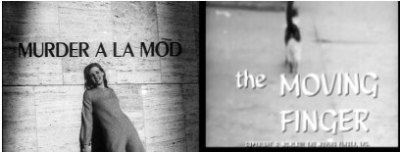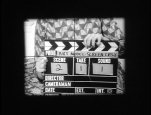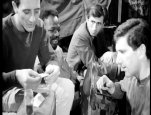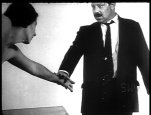| Reviews & Columns |
|
Reviews DVD TV on DVD Blu-ray 4K UHD International DVDs In Theaters Reviews by Studio Video Games Features Collector Series DVDs Easter Egg Database Interviews DVD Talk Radio Feature Articles Columns Anime Talk DVD Savant Horror DVDs The M.O.D. Squad Art House HD Talk Silent DVD
|
DVD Talk Forum |
|
|
| Resources |
|
DVD Price Search Customer Service #'s RCE Info Links |
|
Columns
|
|
|
Murder A La Mod / The Moving Finger

 Welcome to one of two September offerings from Something Weird Video, that purveyor of pulchritude, those merchants of miscreance, that storehouse of sleaze, and panderer of fine female flesh and cinematic carnality from the past half century. Exploitation's finest preservationists and historians make every release a real gratuitous grab bag, and this time around, we are privileged to witness the beginning chapter of one of cinema's most celebrated careers. There was a time, near the end of the '60s and up through the early '80s, when Brian DePalma was a cinematic superstar on par with his considered contemporaries – Stephen Spielberg, George Lucas, Francis Ford Coppola and Martin Scorsese. 1967's Murder a La Mod represents one of his first attempt at meshing the creative with the craven, using the gritty New York grindhouse scene as a backdrop for his atypical whodunit. Unfortunately, its co-feature can't hold up its end of the entertainment bargain. Though it wants to be a memento to a time of coffee, carnality and crime, The Moving Finger from 1963 gives audiences a mean-spirited middle digit when it comes to competency and consideration. It's like watching a bunch of bums adlib for 81 minutes.
Welcome to one of two September offerings from Something Weird Video, that purveyor of pulchritude, those merchants of miscreance, that storehouse of sleaze, and panderer of fine female flesh and cinematic carnality from the past half century. Exploitation's finest preservationists and historians make every release a real gratuitous grab bag, and this time around, we are privileged to witness the beginning chapter of one of cinema's most celebrated careers. There was a time, near the end of the '60s and up through the early '80s, when Brian DePalma was a cinematic superstar on par with his considered contemporaries – Stephen Spielberg, George Lucas, Francis Ford Coppola and Martin Scorsese. 1967's Murder a La Mod represents one of his first attempt at meshing the creative with the craven, using the gritty New York grindhouse scene as a backdrop for his atypical whodunit. Unfortunately, its co-feature can't hold up its end of the entertainment bargain. Though it wants to be a memento to a time of coffee, carnality and crime, The Moving Finger from 1963 gives audiences a mean-spirited middle digit when it comes to competency and consideration. It's like watching a bunch of bums adlib for 81 minutes.
By dissecting each entry individually, we will uncover the veracity behind the vice and the outrage beneath the ogling. Let's start with:

Murder a La Mod
Rating: Va-Va-Va-Voom
 Plot: Karen is the kind of cosmopolitan kitten who slinks through Manhattan like the Big Apple is purposely being cored just for her.
Plot: Karen is the kind of cosmopolitan kitten who slinks through Manhattan like the Big Apple is purposely being cored just for her.  She meets up with her high minded society matron friend, and the two have a heart to heart about life and love. Seems Karen adores Christopher, a maker of artistic films, and she doesn't understand why, even with a marriage proposal in hand, he seems uninterested in consummating their burgeoning love affair. Turns out that Chris needs some cash. He says it's to divorce his henpecking wife. In actuality, he needs the dough to finish up some more of his cinema de skin. Yep, Chris is a pornographer, and with his producer pal and sidekick with an ice pick Otto, he gets gals to drop their…inhibitions and make with the modeling. Desperate for some bread to help her beau, Karen steals a sack of securities from her rich witch pal, and before you know it, someone throttles her with the business end of…that's right, an ice pick. Naturally Otto is the prime suspect. But things aren't often as they seem in this mangled mystery. We get to witness every angle of the crime, from the discovery of the body and its unusual disposal to the heinous act itself. It makes for one totally trashy Murder A La Mod.
She meets up with her high minded society matron friend, and the two have a heart to heart about life and love. Seems Karen adores Christopher, a maker of artistic films, and she doesn't understand why, even with a marriage proposal in hand, he seems uninterested in consummating their burgeoning love affair. Turns out that Chris needs some cash. He says it's to divorce his henpecking wife. In actuality, he needs the dough to finish up some more of his cinema de skin. Yep, Chris is a pornographer, and with his producer pal and sidekick with an ice pick Otto, he gets gals to drop their…inhibitions and make with the modeling. Desperate for some bread to help her beau, Karen steals a sack of securities from her rich witch pal, and before you know it, someone throttles her with the business end of…that's right, an ice pick. Naturally Otto is the prime suspect. But things aren't often as they seem in this mangled mystery. We get to witness every angle of the crime, from the discovery of the body and its unusual disposal to the heinous act itself. It makes for one totally trashy Murder A La Mod.
 At first, Murder A La Mod is too quirky for words. One barely gets through the initial montage of models and director dishing Q&A before thinking that nothing good can come of this purposely peculiar mess.
At first, Murder A La Mod is too quirky for words. One barely gets through the initial montage of models and director dishing Q&A before thinking that nothing good can come of this purposely peculiar mess.  Then Karen steps in to discuss her love life with a Diane Von Furstenberg imitator and we suddenly start to get our bearings. Before long, DePalma is carefully tweaking the elements of the standard thriller, imposing slapstick, horror and darkly comedic moments on the genre's rather pat format. The result is a movie that keeps guiding us down ever blinder alleys and wickedly wrong conclusions. We think we've got the eventual crime all figured out (rendered rather realistically, including a gory eye gouging) when DePalma tosses in an unexpected twist. Indeed, like most of his oeuvre, Murder A La Mod is more concerned with perception that plotting. Obviously still under the influence of both the French New Wave and Hitchcock, DePalma wants to purposefully play with the thriller's considered trappings. He wants the murder to mean less than the mannered methodology he uses to recreate and reinterpret it. In reality, the narrative is kind of naïve. There are only three people who could possibly be guilty, and since we are going to see how each one spent their pre-slaughter time, we realize that eventually we'll know the truth as well. So there is not a lot of suspense in this overly stylized saga. Instead, we are witness to some of the director's more interesting cinematic choices in a film that is ultimately satisfying, despite its shaky start.
Then Karen steps in to discuss her love life with a Diane Von Furstenberg imitator and we suddenly start to get our bearings. Before long, DePalma is carefully tweaking the elements of the standard thriller, imposing slapstick, horror and darkly comedic moments on the genre's rather pat format. The result is a movie that keeps guiding us down ever blinder alleys and wickedly wrong conclusions. We think we've got the eventual crime all figured out (rendered rather realistically, including a gory eye gouging) when DePalma tosses in an unexpected twist. Indeed, like most of his oeuvre, Murder A La Mod is more concerned with perception that plotting. Obviously still under the influence of both the French New Wave and Hitchcock, DePalma wants to purposefully play with the thriller's considered trappings. He wants the murder to mean less than the mannered methodology he uses to recreate and reinterpret it. In reality, the narrative is kind of naïve. There are only three people who could possibly be guilty, and since we are going to see how each one spent their pre-slaughter time, we realize that eventually we'll know the truth as well. So there is not a lot of suspense in this overly stylized saga. Instead, we are witness to some of the director's more interesting cinematic choices in a film that is ultimately satisfying, despite its shaky start.
The Moving Finger
Rating; Not So Nudie or Cutie
 Plot: Down in the Village, Anatole runs the seediest, sleaziest tourist trap coffeehouse this side of a mall Starbucks, employing a group of hygienically challenged beatniks to be his "local color".
Plot: Down in the Village, Anatole runs the seediest, sleaziest tourist trap coffeehouse this side of a mall Starbucks, employing a group of hygienically challenged beatniks to be his "local color".  Unhappy with their added ambiance lot in life, the group dreams of the day when stinking to high heaven becomes a viable career choice. With a little cash, Mason can move to Mexico, and bring along his jailbait babe Bridget. Though she looks like a shaved collie, all the men in the lower Burroughs pine away for this petite little lass, including a lecherous member of local law enforcement. He spends more time propositioning Bridget than looking for the bank robber who recently made off with $90K from a nearby bank. All he has to do is look in the basement pad where the social rejects crash. They've actually taken in the hood, hoping to get their hands on his loot. Of course, our criminal caught some lead along the way, and a drunken quack doctor demands a cut to guarantee his ills will be fatal. Next, Anatole's ladylove, Angel, discovers the beat's secret, and wants in on the pecuniary action. Then Anatole finds out. Soon, it's a race against time – and talent – as everyone waits for the criminal to croak so they can snatch his stash. Yet as long as he has a Moving Finger, they won't be able to benefit from his ill-gotten gains.
Unhappy with their added ambiance lot in life, the group dreams of the day when stinking to high heaven becomes a viable career choice. With a little cash, Mason can move to Mexico, and bring along his jailbait babe Bridget. Though she looks like a shaved collie, all the men in the lower Burroughs pine away for this petite little lass, including a lecherous member of local law enforcement. He spends more time propositioning Bridget than looking for the bank robber who recently made off with $90K from a nearby bank. All he has to do is look in the basement pad where the social rejects crash. They've actually taken in the hood, hoping to get their hands on his loot. Of course, our criminal caught some lead along the way, and a drunken quack doctor demands a cut to guarantee his ills will be fatal. Next, Anatole's ladylove, Angel, discovers the beat's secret, and wants in on the pecuniary action. Then Anatole finds out. Soon, it's a race against time – and talent – as everyone waits for the criminal to croak so they can snatch his stash. Yet as long as he has a Moving Finger, they won't be able to benefit from his ill-gotten gains.
 My, oh my, is The Moving Finger a test of one's tenacity and patience.
My, oh my, is The Moving Finger a test of one's tenacity and patience.  So earnest it practically reeks of fresh roasted java beans, and as arch as much of the bad beat poetry we hear being spoken, this attempt to capture the flavor and finesse of the early '60s East Village scene is like watching a US Government public service announcement on being hip. With a cast of considered scenery snackers, including future Petrocelli Barry Newman and eventual Hart to Hart helper Lionel Stander, this mostly improvised aggravation is like seventeen uninteresting stories all loosely linked together with body hair. First there's the bank robbery, then the dire situation of the sticky with filth freeloaders. Next we get Stander's stale doggerels, followed by a cop's creepy proposition to an awkward adolescent. Then, eventually, the plot kicks in. Never one to miss a pointless situation, director Larry Moyer films a freak-out party scene in some manner of stunted real time. As booties shake and individuals gad about, the temporal plane actually appears to slow and then stop. Before we know it, we are adrift in a wormhole of worthlessness, lost lonely and very afraid. No matter its culturally correct aims, its desire to dig deep beneath the whole On the Road realities of the era, The Moving Finger fails to fully connect with a viewer. We are left wondering about too many legitimate loose ends – who's who and why we should care – to begin to buy the whole alternative scene situation. Sadly, even the skin is thin and waiflike.
So earnest it practically reeks of fresh roasted java beans, and as arch as much of the bad beat poetry we hear being spoken, this attempt to capture the flavor and finesse of the early '60s East Village scene is like watching a US Government public service announcement on being hip. With a cast of considered scenery snackers, including future Petrocelli Barry Newman and eventual Hart to Hart helper Lionel Stander, this mostly improvised aggravation is like seventeen uninteresting stories all loosely linked together with body hair. First there's the bank robbery, then the dire situation of the sticky with filth freeloaders. Next we get Stander's stale doggerels, followed by a cop's creepy proposition to an awkward adolescent. Then, eventually, the plot kicks in. Never one to miss a pointless situation, director Larry Moyer films a freak-out party scene in some manner of stunted real time. As booties shake and individuals gad about, the temporal plane actually appears to slow and then stop. Before we know it, we are adrift in a wormhole of worthlessness, lost lonely and very afraid. No matter its culturally correct aims, its desire to dig deep beneath the whole On the Road realities of the era, The Moving Finger fails to fully connect with a viewer. We are left wondering about too many legitimate loose ends – who's who and why we should care – to begin to buy the whole alternative scene situation. Sadly, even the skin is thin and waiflike.
The A/V Club
Rating: Va-Va-Va-Voom!
It's time for some disobedient displays of digital remastering as Something Weird Video unearths a pair of provocative monochrome prints. The transfers here are terrific, each one representing some of the best that black and white filmmaking has to offer. Murder A La Mod looks especially good, considering its rarity and relative experimentalism, while The Moving Finger offers details so dense and considered you can see the individual wisps of hair cemented to Lionel Stander's balding skull. SWV deserves plenty of thanks from happy film fans, especially those interested in DePalma's earliest cinematic phase. Sonically, there are no complaints with the typical Dolby Digital Mono mix.
Added Attractions:
Rating: Standard Skin Fare
 The only bonus feature here is a sloppy short film made up mostly of cheesecake snapshots and stale stock footage. Entitled An Eye for the Girls, this men's magazine come to life is like watching a Hustler spread speak. While hardly as graphic as the aforementioned Larry Flint rag, the images are indeed highly reminiscent of those incredibly odd National Lampoon photo "funnies", where men would meet sexually adventurous – and frequently undressed – women. Naturally, all manner of hilarious hi-jinx would ensue. In the case of this hopeless Harold Klein production, the comedy is completely cut out, with boredom and irritation taking its place. The constant repetition of shots (many of the reactions are monotonously milked over and over again) and the "oh, aren't I a stitch" narrator make for one groan inducing bit of gratuity. After this 60 minutes of misery, you may have an eye for the girls, but your entertainment tolerances will be severely tested – if not completely drained.
The only bonus feature here is a sloppy short film made up mostly of cheesecake snapshots and stale stock footage. Entitled An Eye for the Girls, this men's magazine come to life is like watching a Hustler spread speak. While hardly as graphic as the aforementioned Larry Flint rag, the images are indeed highly reminiscent of those incredibly odd National Lampoon photo "funnies", where men would meet sexually adventurous – and frequently undressed – women. Naturally, all manner of hilarious hi-jinx would ensue. In the case of this hopeless Harold Klein production, the comedy is completely cut out, with boredom and irritation taking its place. The constant repetition of shots (many of the reactions are monotonously milked over and over again) and the "oh, aren't I a stitch" narrator make for one groan inducing bit of gratuity. After this 60 minutes of misery, you may have an eye for the girls, but your entertainment tolerances will be severely tested – if not completely drained.
Grindhouse Grade: Nice and Sleazy (Highly Recommended)
 So what, you may ask, is an early DePalma experimental film, a kind of Rashomon on mushrooms doing as part of the Something Weird canon? After all, while his Peace decade efforts are well intentioned if frequently fractured avant-garde grooves, they are barely exploitation. As a matter of fact, you will be hard pressed to find much flesh in this murder mystery with a beatnik twist. Yet students of the genre will immediately get the connection to the raincoat crowd. Certainly the grindhouse was known more for its pandering and pulchritude, its desire to take advantage of sin and skin to maximum box office success. But the producers of the era also understood the value in the underground, both as a potential talent pool as well as a source of undiscovered ideas and approaches. Never one to miss an opportunity, the industry's infamous 40 Thieves would occasionally sponsor a less than tantalizing title, more as a means of legitimizing their business than catering to the bottom line. Thus hungry filmmakers like DePalma found their efforts being championed as kind of an antidote to the typical Hollywood hokum. On the Grindhouse Grading scale, DePalma's efforts definitely carry the day. This is a Nice and Sleazy presentation, with only the below average beatnik nonsense and lack of significant added content undermining the offering.
So what, you may ask, is an early DePalma experimental film, a kind of Rashomon on mushrooms doing as part of the Something Weird canon? After all, while his Peace decade efforts are well intentioned if frequently fractured avant-garde grooves, they are barely exploitation. As a matter of fact, you will be hard pressed to find much flesh in this murder mystery with a beatnik twist. Yet students of the genre will immediately get the connection to the raincoat crowd. Certainly the grindhouse was known more for its pandering and pulchritude, its desire to take advantage of sin and skin to maximum box office success. But the producers of the era also understood the value in the underground, both as a potential talent pool as well as a source of undiscovered ideas and approaches. Never one to miss an opportunity, the industry's infamous 40 Thieves would occasionally sponsor a less than tantalizing title, more as a means of legitimizing their business than catering to the bottom line. Thus hungry filmmakers like DePalma found their efforts being championed as kind of an antidote to the typical Hollywood hokum. On the Grindhouse Grading scale, DePalma's efforts definitely carry the day. This is a Nice and Sleazy presentation, with only the below average beatnik nonsense and lack of significant added content undermining the offering.
The Grindhouse Grading System:
Va-Va-Va-Voom - The Tip Top of Titillation: 5 out of 5
Nice and Sleazy – Better Than Average Action: 4 out of 5
Standard Skin Fare – Your Typical Exploitation Elements: 3 out of 5
Not So Nudie or Cutie – Cut Rate Carnality: 2 out of 5
More Stinky than Kinky – Barely Worth the Bodkin: 1 out of 5
Limp and Lifeless – Not Worth Your Raincoat: 0 out of 5
Want more Gibron Goodness? Come to Bill's TINSEL TORN REBORN Blog (Updated Frequently) and Enjoy! Click Here
|
| Popular Reviews |
| Sponsored Links |
|
|
| Sponsored Links |
|
|
| Release List | Reviews | Shop | Newsletter | Forum | DVD Giveaways | Blu-Ray | Advertise |
|
Copyright 2024 DVDTalk.com All Rights Reserved. Legal Info, Privacy Policy, Terms of Use,
Manage Preferences,
Your Privacy Choices | |||||||













